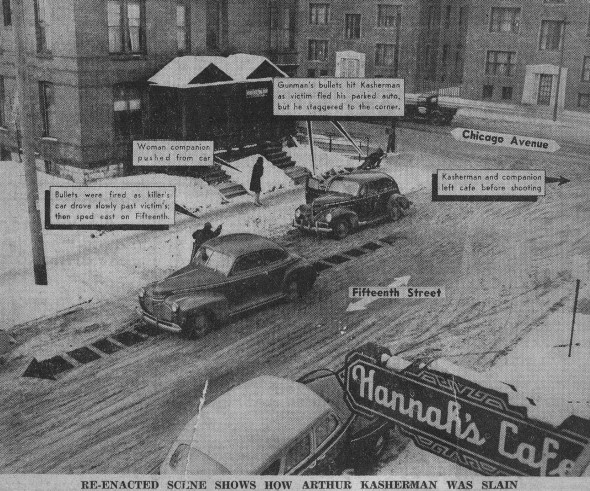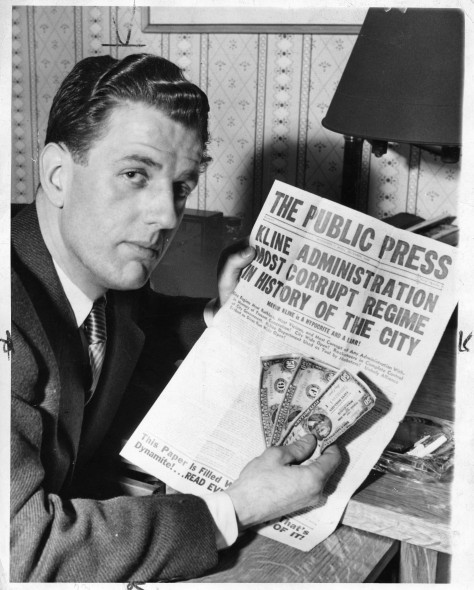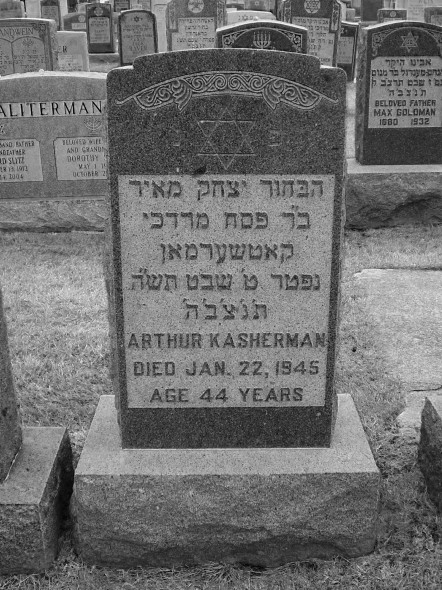The aftermath
In the days after Arthur Kasherman’s murder, few would have predicted that it would change the direction of the city.
The killing earned four paragraphs in Time Magazine on Feb. 3, 1945. Its headline properly noted Kasherman was “Victim No. 3,” acknowledging his membership in that sad trio. While imputing some journalistic “legitimacy” to the two previously murdered Minneapolis newspapermen, Kasherman “had none.” It was a “wonder that anyone wasted a bullet on Kasherman,” the unnamed correspondent wrote, deriding his “thin face and slickly pompadoured black hair” and asserting that his newspaper was all about smearing “the cops, the mayor and the gangsters…”
It ends with this disturbing sentence: “Minneapolis’ legitimate newspapers cluck-clucked properly over Kasherman’s death, hoping that the latest killing would do what police and city officials had failed to do: put a stop to blackmail parading as journalism.”

The Minneapolis Star Journal staged this re-enactment for a front page photo illustration for its Jan. 23, 1945 edition
The moral, then: Kasherman was a petty criminal, a journalistic impostor, whose removal from the streets was a disinfectant. The greater offense, once again: crime masquerading as journalism, not a man dying because someone didn’t like what he wrote. Time’s article announced to the nation that Kasherman’s death should be a matter of celebration, not outrage.
Yet the third drive-by killing of a journalist in 11 years was the third strike for Minneapolis.
The records that survive of the Minneapolis police investigation reveal a meandering and half-hearted inquiry. Though the detectives collected Kasherman’s writings, they never sought clues within them. They talked to some mental patients who claimed responsibility, and chased some dubious leads to Chicago and New Orleans. They did get around to talking to real gangsters, people who likely knew something about why Kasherman was bumped off. Unless they were expecting a spontaneous confession, the cops were just going through the motions. No one collected Mayor Marvin Kline’s promised $500 reward. Even Kasherman’s brother, Ed Keller, described the deceased as mentally ill and predicted that no one would ever be held responsible for the homicide.
In a futile gesture, someone associated with a good government group brought a list of questions to the grand jury investigating the murder. One of them said, “Don’t you think ‘Truth’ should predominate – wouldn’t you say there was some truth in Kasherman’s paper? Did you ignore his exposure?”
There’s nothing in the police file that indicates those questions were ever answered.
But there were investigators who had motives to solve the case, beyond justice for Arthur Kasherman. The day after Kasherman’s murder, detectives combed through boxes full of papers in what the newspapers breathlessly described as Kasherman’s “secret archive,” around the corner from his apartment. One of them was William Simms, an investigator in the office of the top prosecutor, Hennepin County Attorney Mike Dillon.
For Dillon and others in Minnesota’s newly created Democratic-Farmer-Labor Party, Kasherman’s death had become a symbol of a city still ruled by gangsters, and it was seized upon by supporters of a young DFL mayoral candidate, Hubert Humphrey. Two years earlier, Simms had been planted in the prosecutor’s office by Humphrey and his supporters for the sole purpose of gathering evidence of police corruption. That evidence could help build Humphrey’s case for his second challenge against Mayor Kline, a Republican.
Simms couldn’t clear Kasherman’s case, but before the election, he found another way to use Kasherman’s relentless attacks on Kline to his patron’s benefit.
One month after Kasherman’s death, the investigation had stalled. Nevertheless, the Minneapolis Star Journal put a story on its front page headlined: “Kasherman ‘Hush Cash’ Discovered.” It’s accompanied by a curious photo: William Simms, the county attorney’s investigator, holding up a copy of the Public Press with the damning headline about Kline’s corrupt regime. The three $50 bills are supposedly “hush money,” concealed in unread newspapers, but in this context clearly stand in for the purported corruption in City Hall.
Simms recalled the circumstances in a 1978 interview: Kasherman was “killed… murdered by presumably some of the underworld characters in Minneapolis. Because of the nature of the death we sought a court permission to go into his safety deposit box, and Mike Dillon and George Totten were the two people that were authorized to open the box. And I was present, and in this box was a copy of this Free Press [sic] newspaper. In the fold of the newspaper, I’ve got a picture of it myself at home, were three $50 bills. What they were … where they came from … nobody ever knew, but … then the picture… appeared in the newspaper with … Kline administration most corrupt in the history of the city.”
During that interview, Simms was talking to Arthur Naftalin, who was Humphrey’s publicist at the time, two political operatives reminiscing about a dirty trick more than 30 years earlier. It was Naftalin who planted the story with a sympathetic reporter at the Star Journal. The story was published weeks before the election, but it fails to note that the man holding the money and the newspaper was Hubert Humphrey’s campaign manager, expertly smearing his opponent with the assistance of a willing media. The same media that felt so superior to people like Arthur Kasherman.
“They never did find out who did it,” recalled Ed Ryan, the Minneapolis police officer lauded by Kasherman in his newspapers. “It was one of those unsolved murders like Howard Guilford, Walter Liggett, Johnson the labor man and I don’t know how many others. But that was just was needed in Humphrey’s campaign because by this time people are really getting fed up. And Humphrey was really going to town on this crime and corruption.”
Humphrey, running on a “clean up the city” platform, crushed Kline in the election. Kasherman blasted Kline out of the mayor’s office after all, even if took a trip to the morgue to do it. Ryan, the man Kasherman constantly boosted in his newspapers, became the police chief.
More than 60 years later, Kasherman still haunts Minneapolis City Hall. He doesn’t have a statue, unlike the man he unintentionally helped elect. The water fountain in the hallway that he once called his “office” is long gone. But he’s there for anyone to see, in the yellowing pages of three of his newspapers, preserved as evidence in a manila file folder in the police records vault, in case anyone ever tries again to find out who rubbed him out.



[…] on Arthur Kasherman’s death, including his Hell-Raising Tradition, the Last Chow Mein and the Aftermath.The project’s short documentary is available on YouTube and Vimeo. There is also an […]
Really wonderful information can be found on web blog . “Time discovers truth.” by Lucius Annaeus Seneca.
As soon as I noticed this site I went on reddit to share some of the love with them.
naturally like your website however you need to test the spelling on several of your posts. A number of them are rife with spelling issues and I find it very bothersome to tell the truth nevertheless I will definitely come again again.
Hey, you used to write fantastic, but the last few posts have been kinda boring… I miss your great writings. Past few posts are just a little bit out of track! come on!
Great – I should definitely pronounce, impressed with your website. I had no trouble navigating through all the tabs as well as related information ended up being truly easy to do to access. I recently found what I hoped for before you know it at all. Quite unusual. Is likely to appreciate it for those who add forums or anything, site theme . a tones way for your client to communicate. Excellent task.
Good write-up, I’m regular visitor of one’s web site, maintain up the nice operate, and It is going to be a regular visitor for a long time.